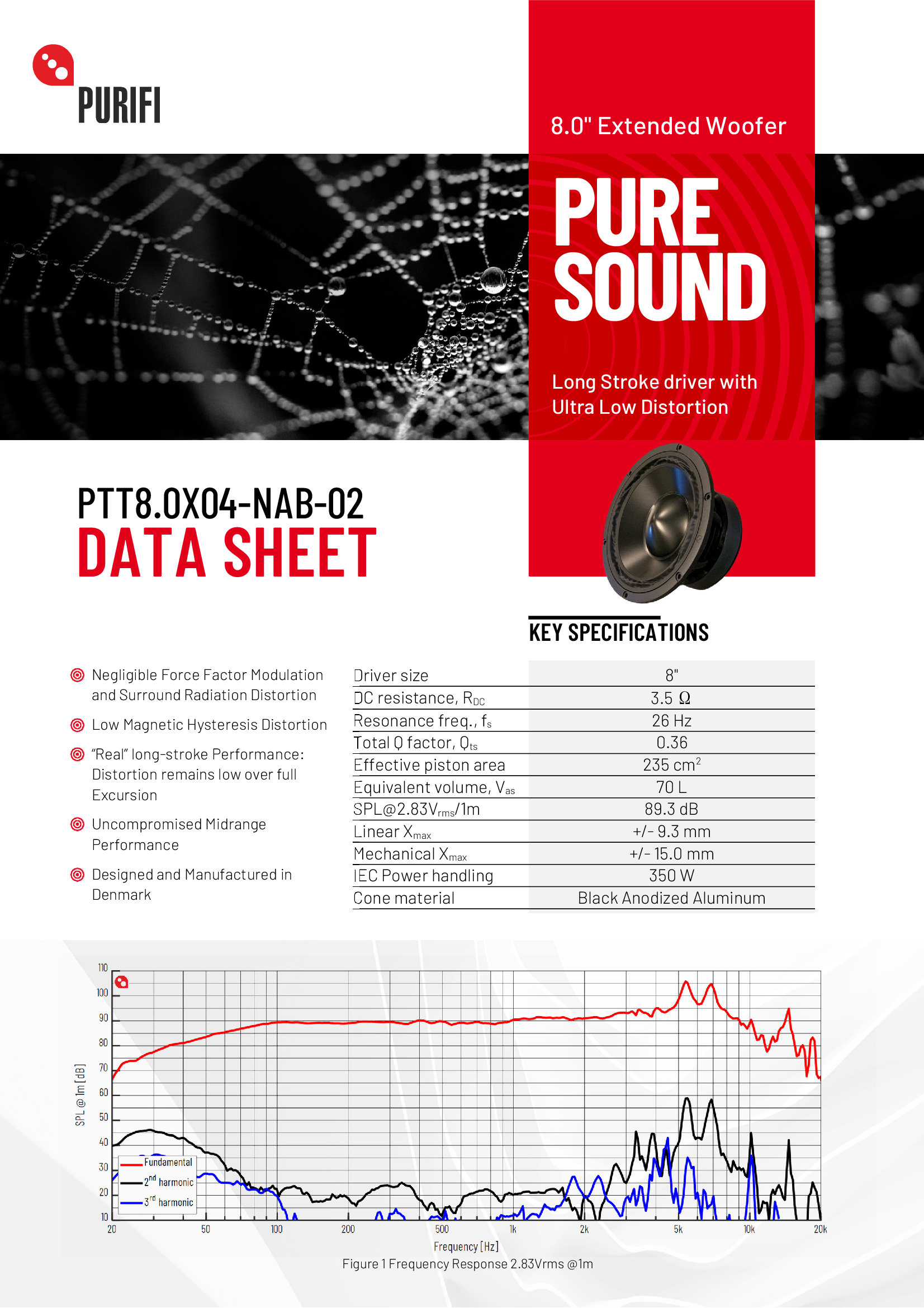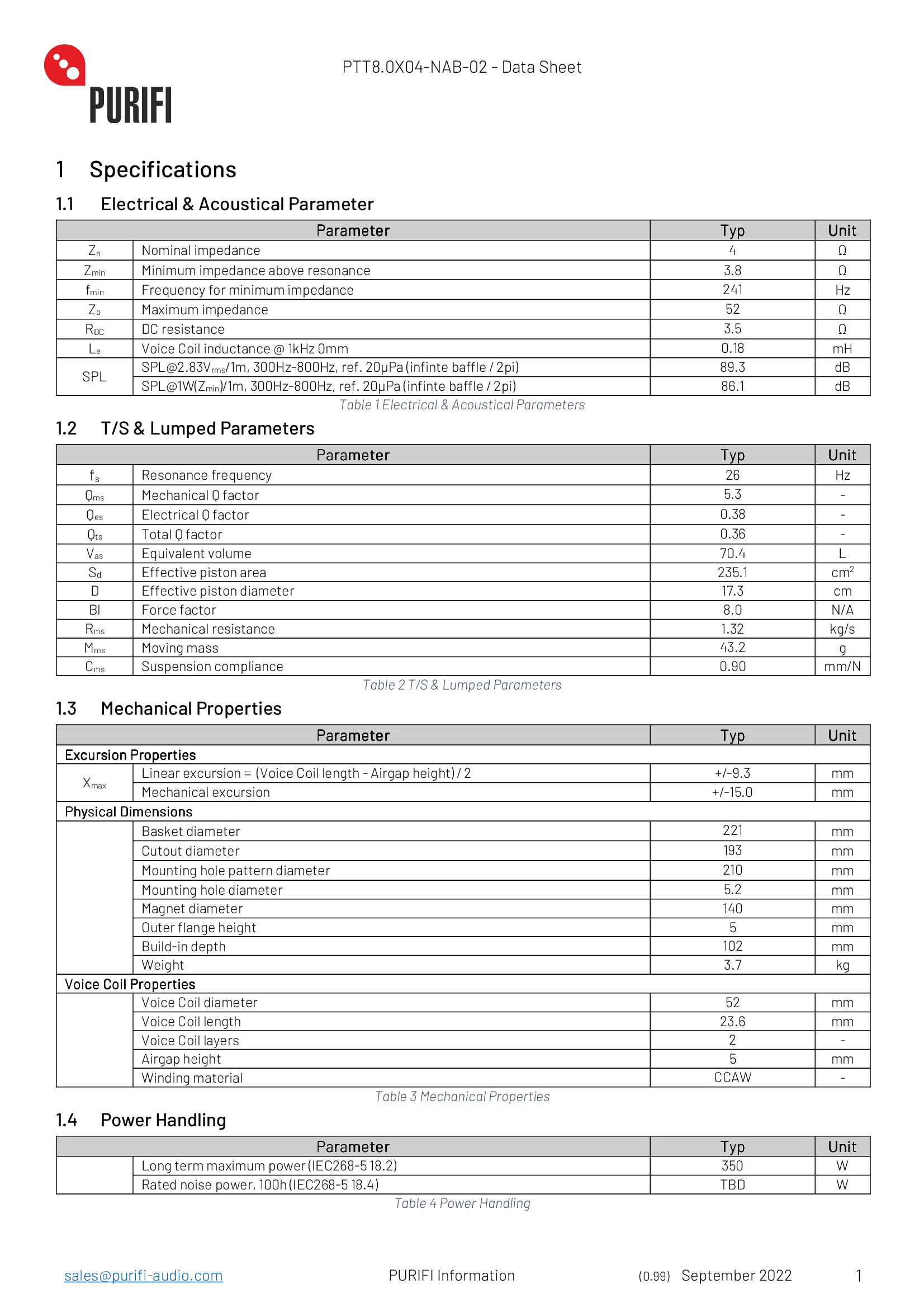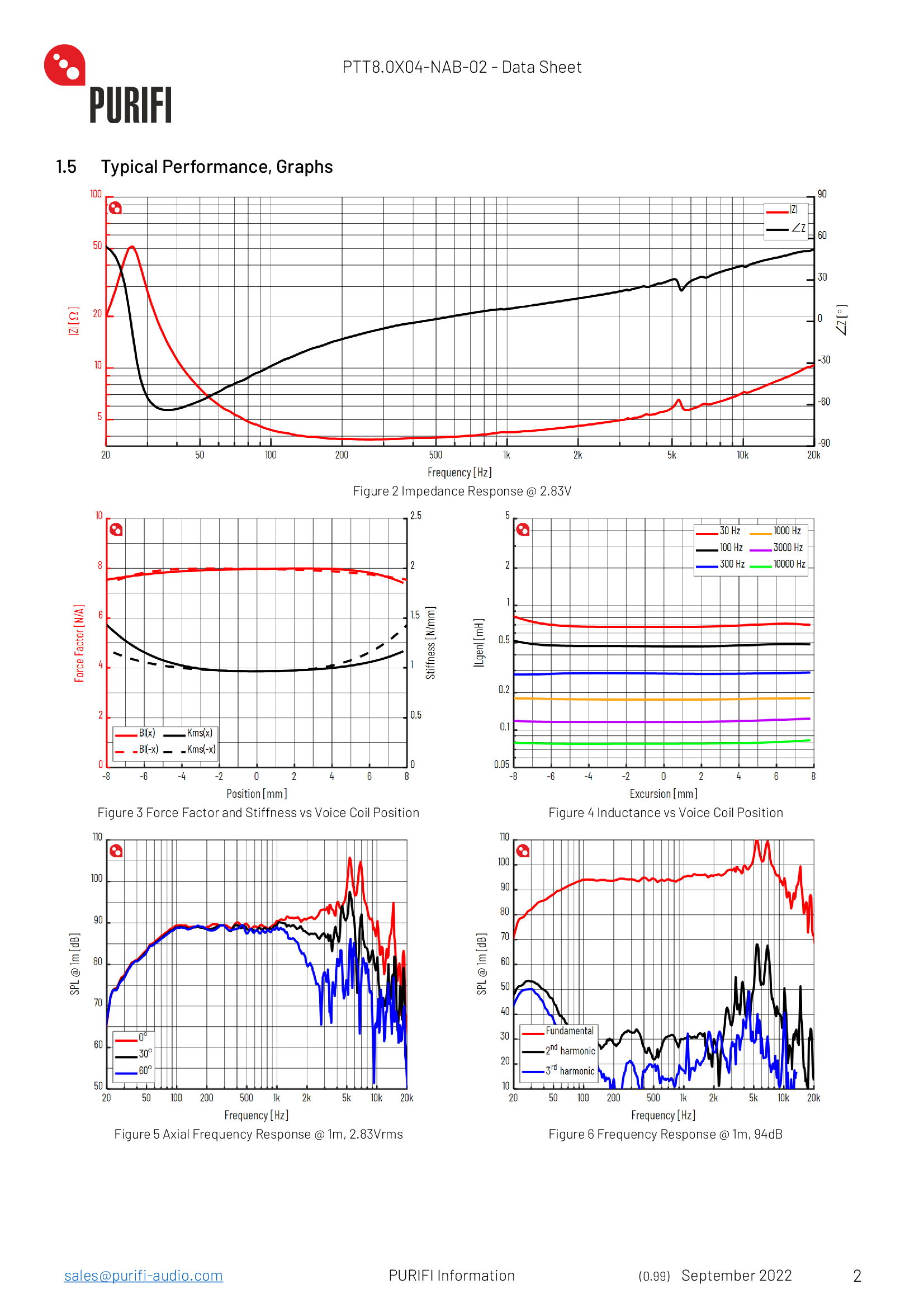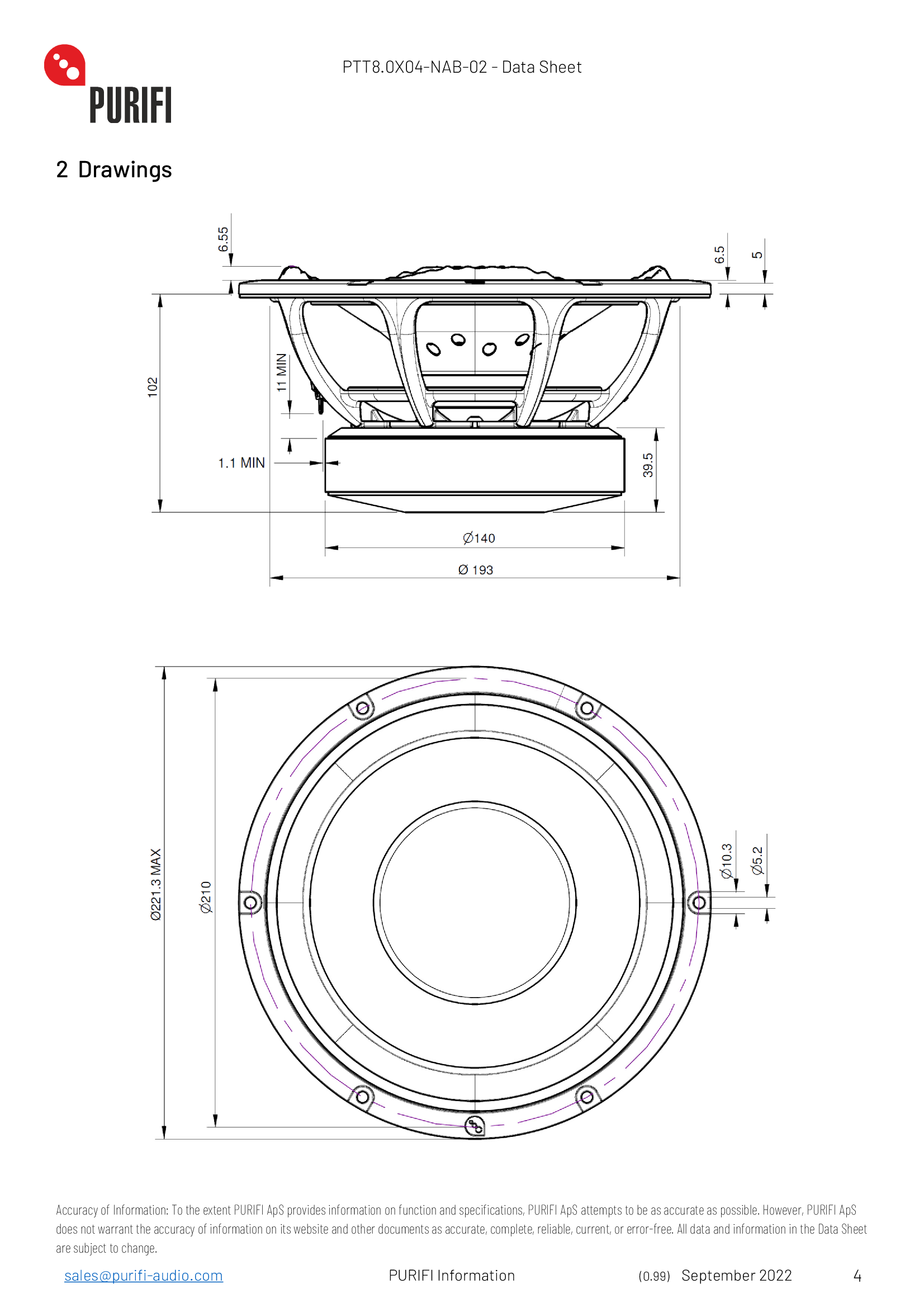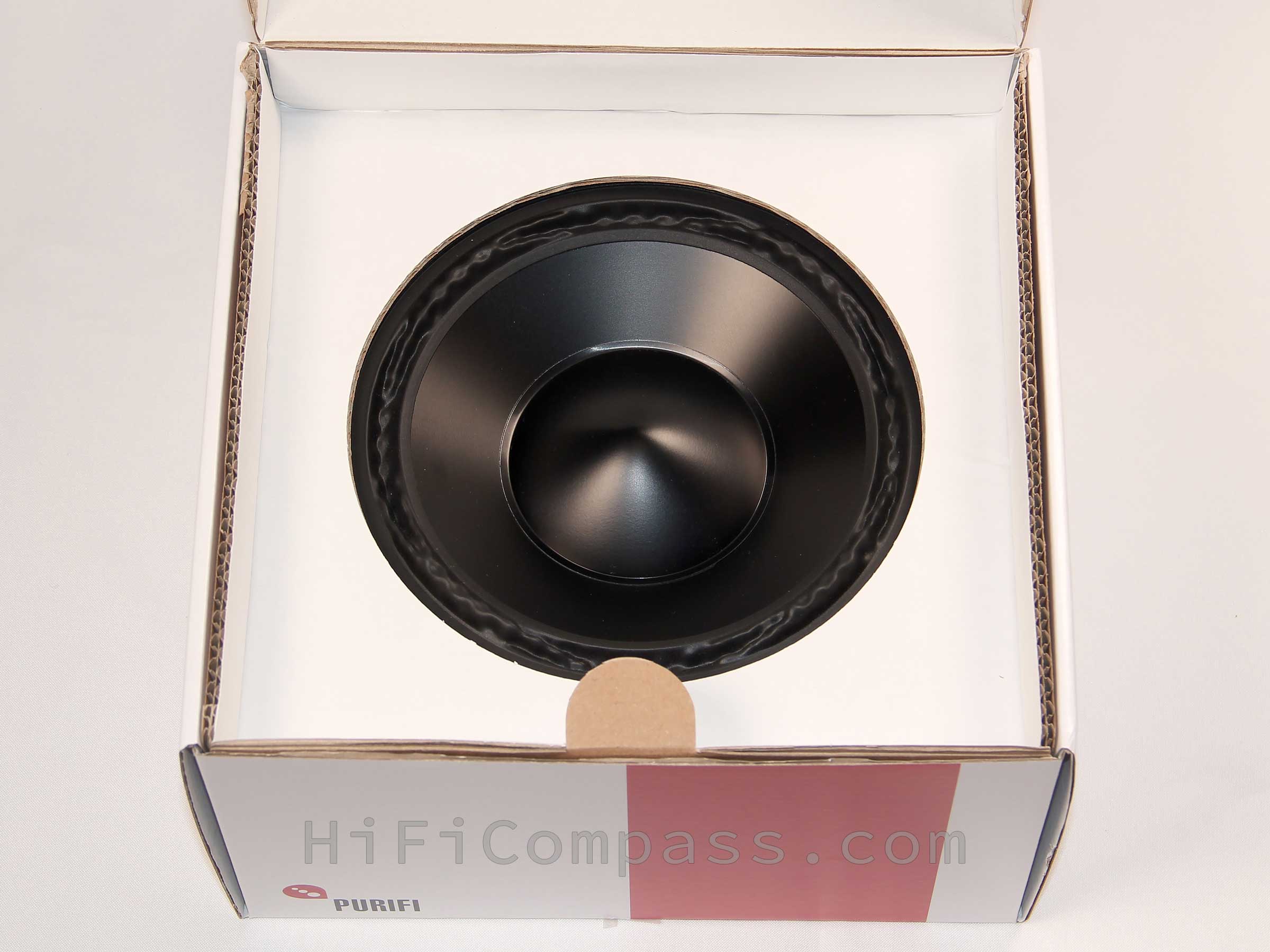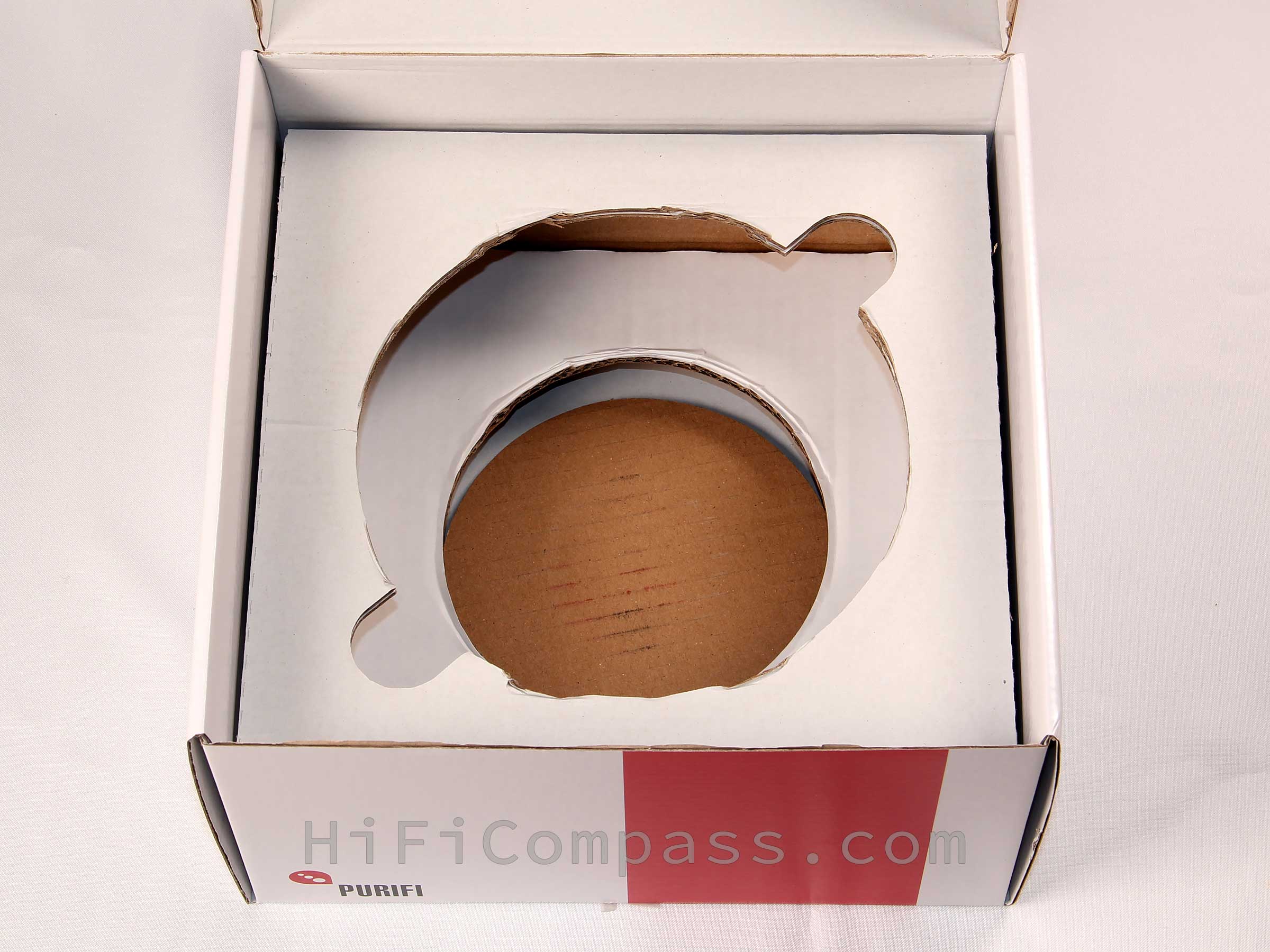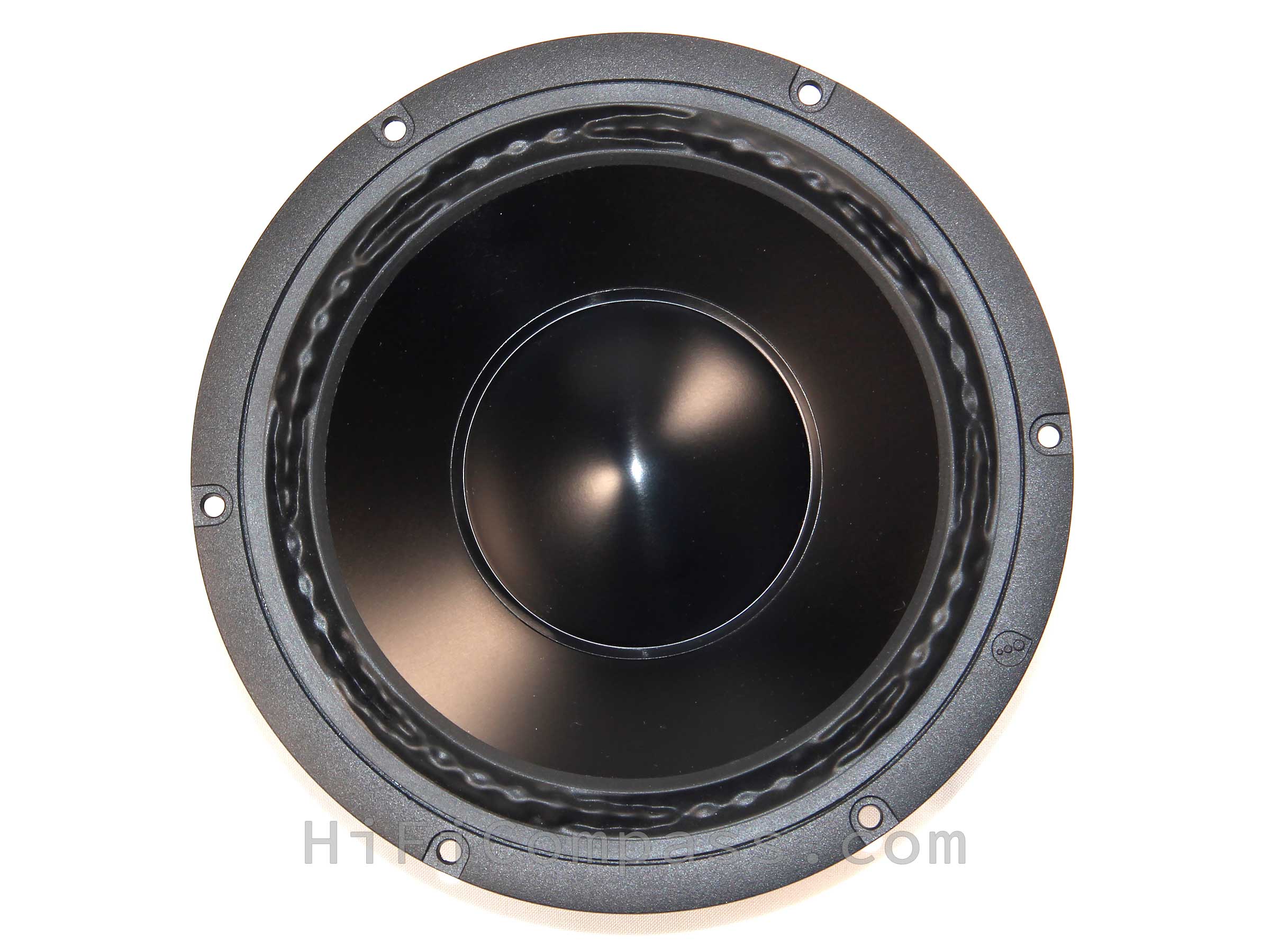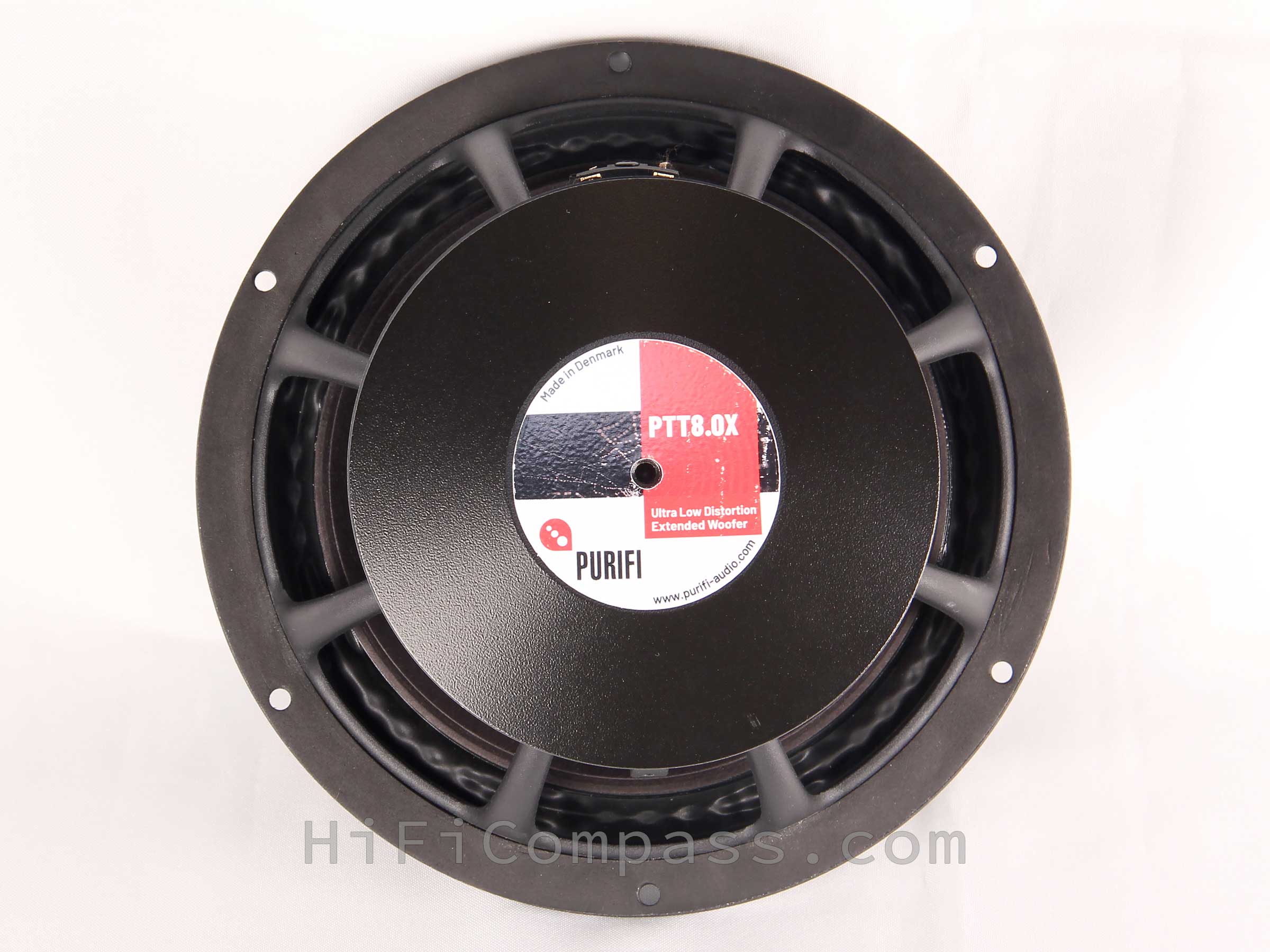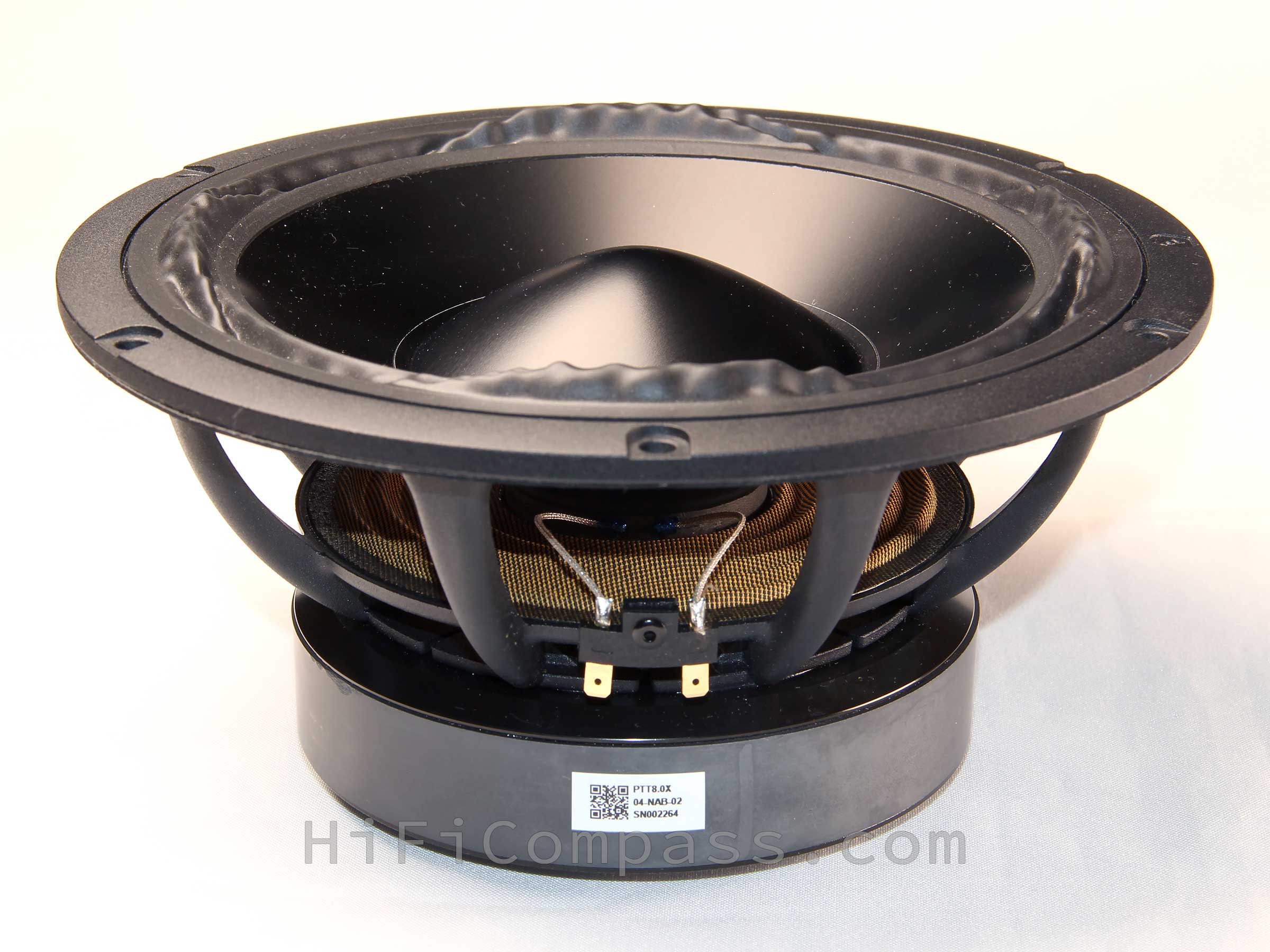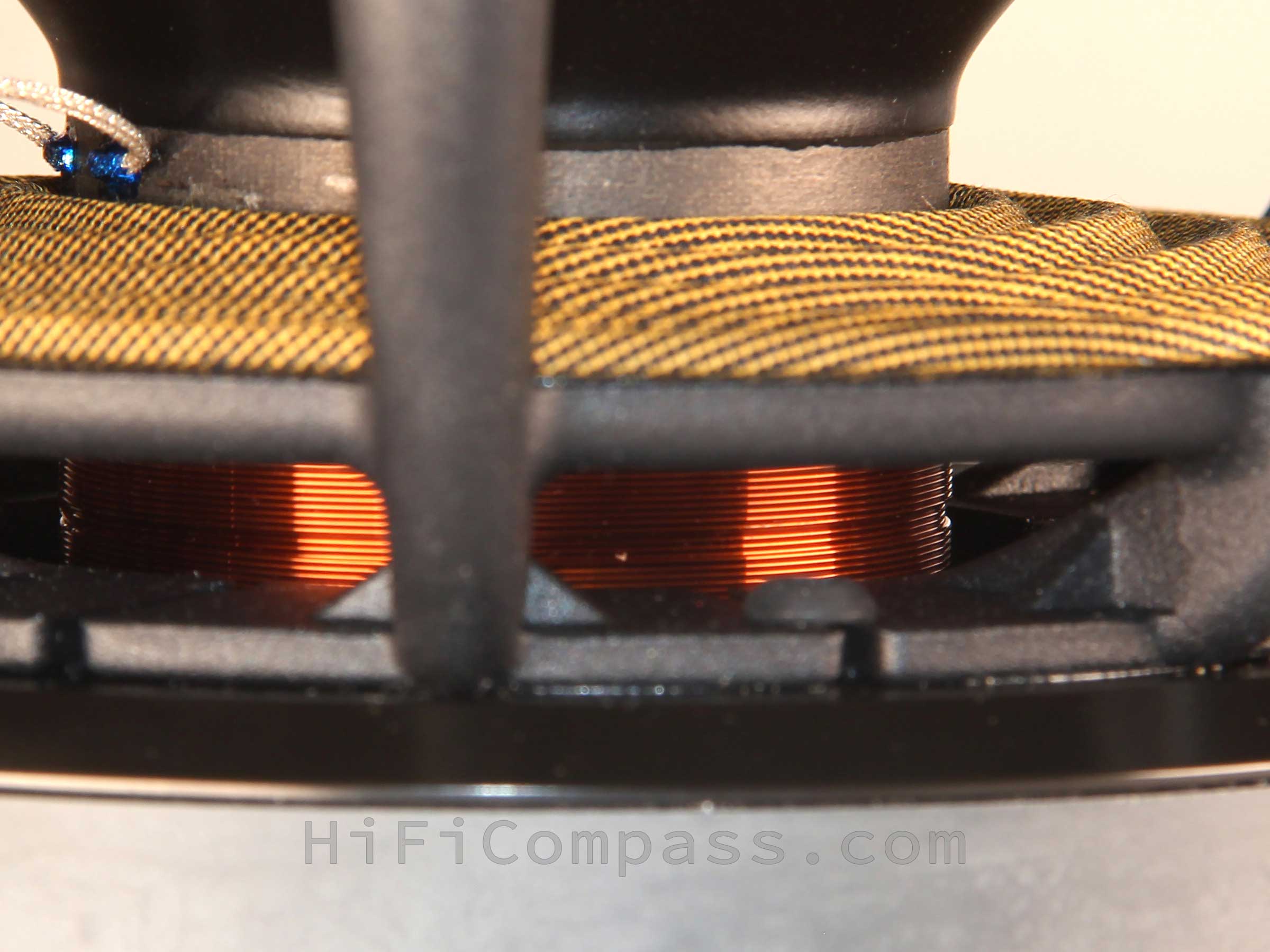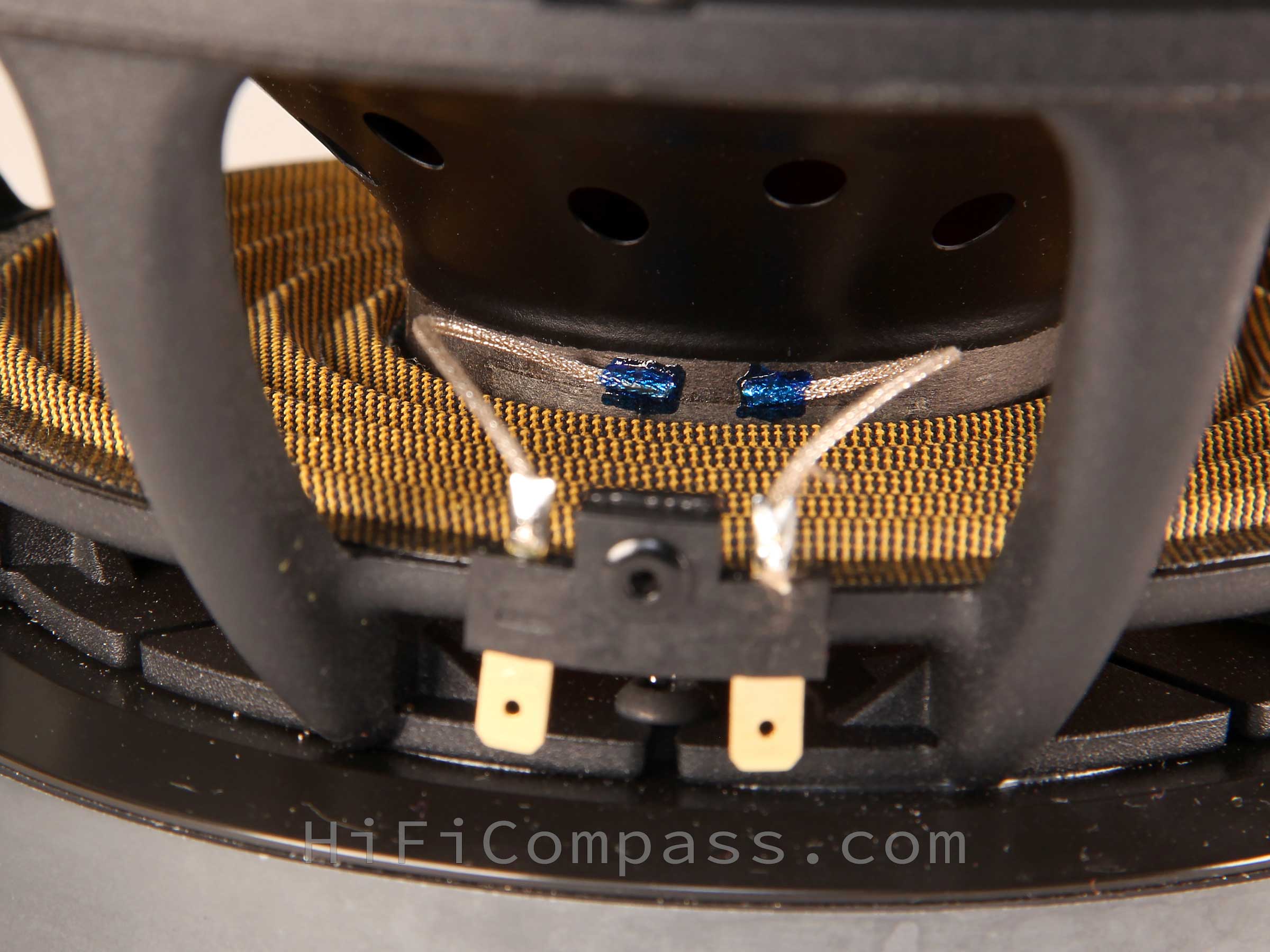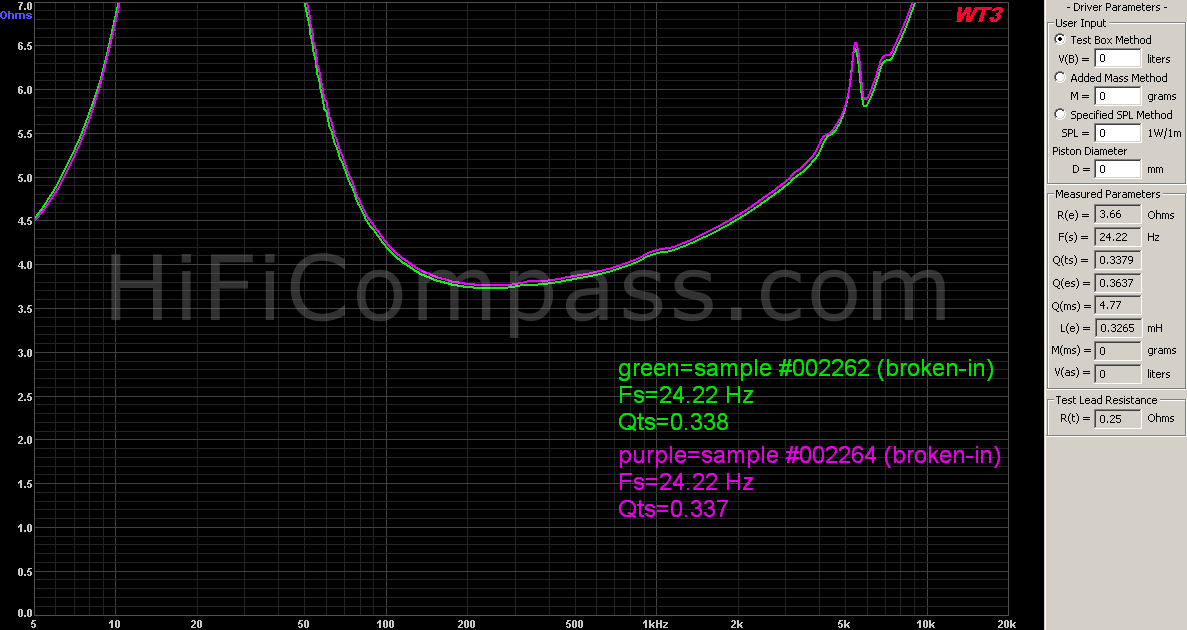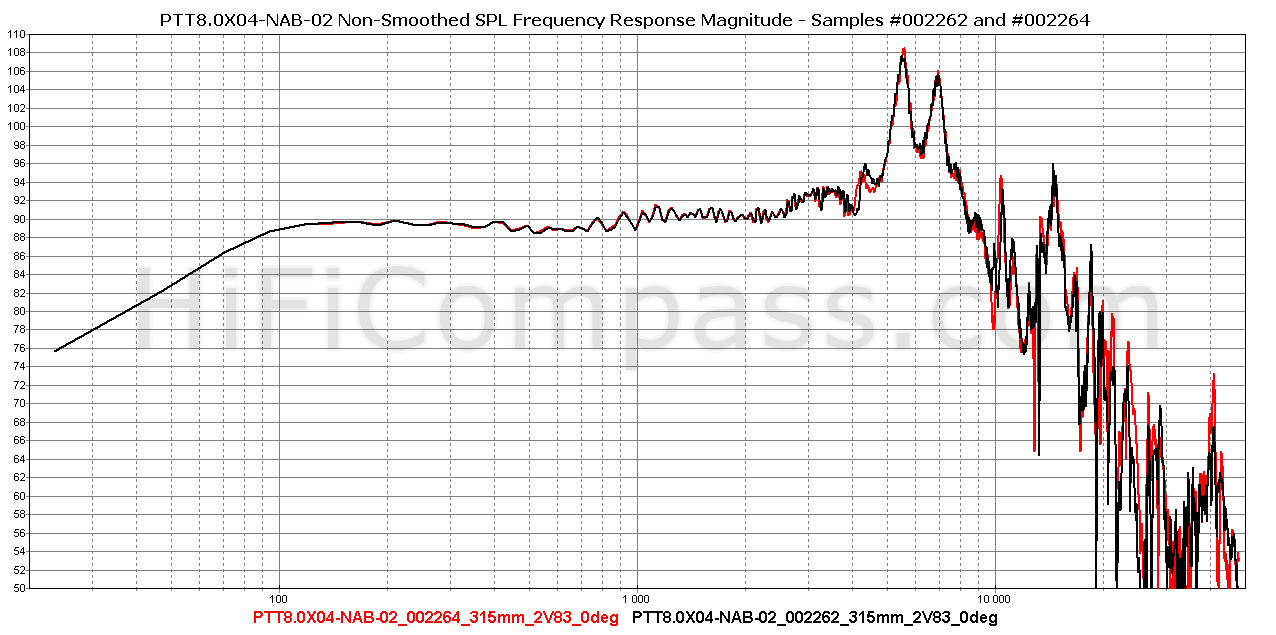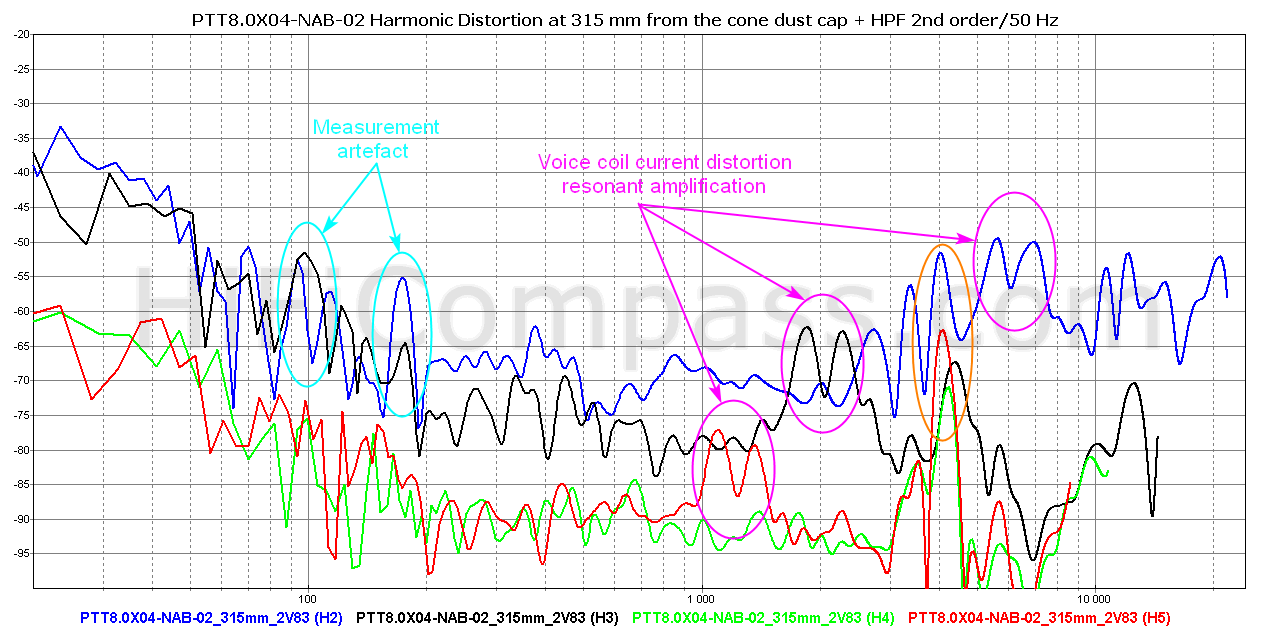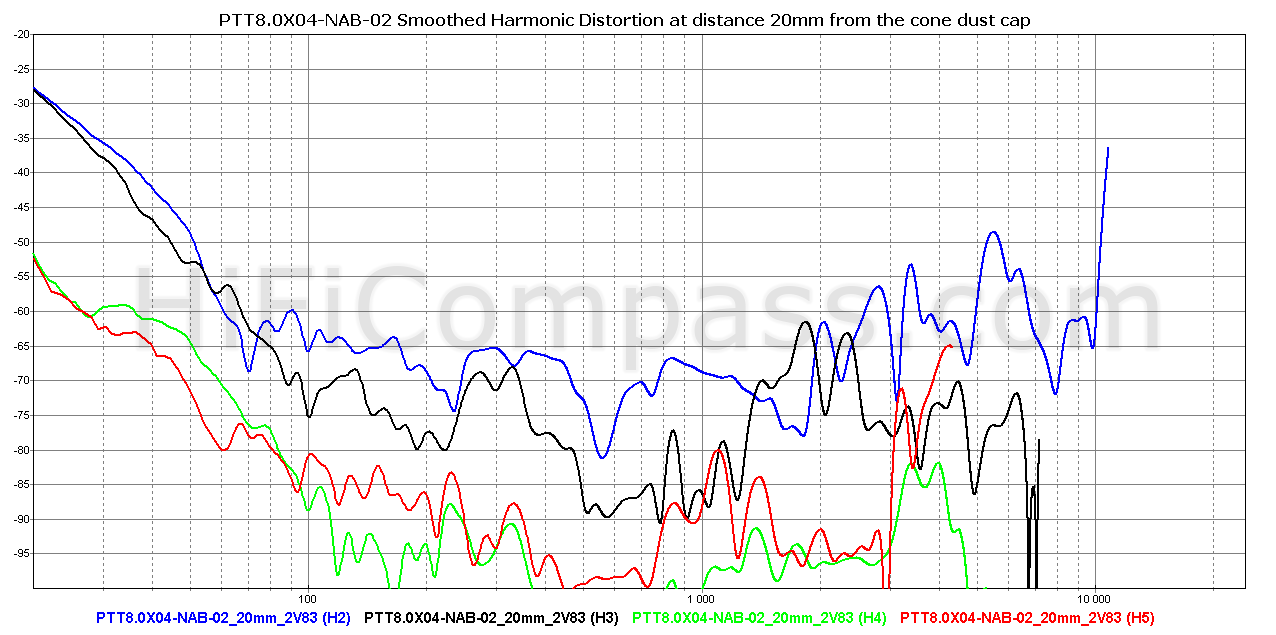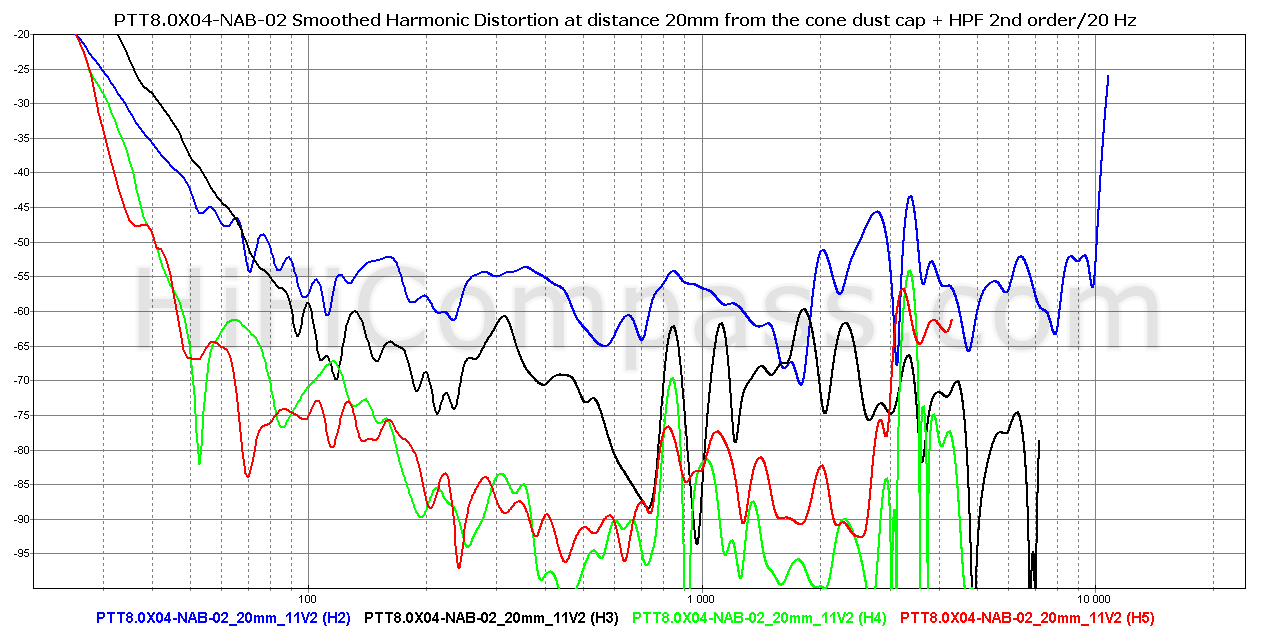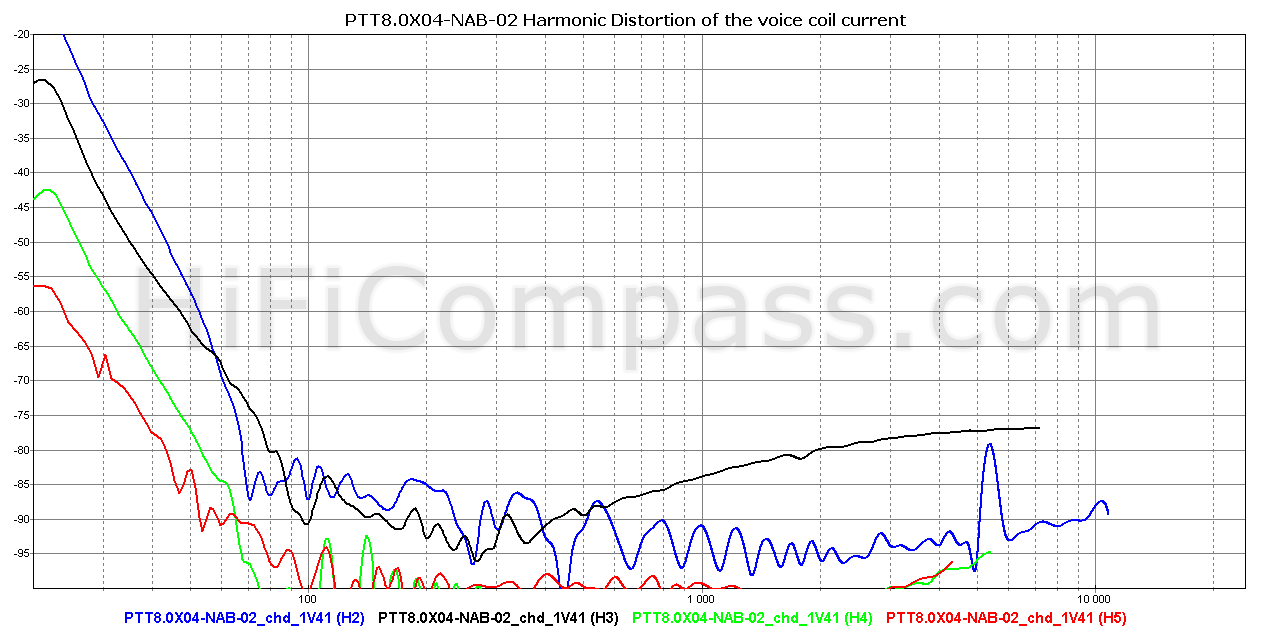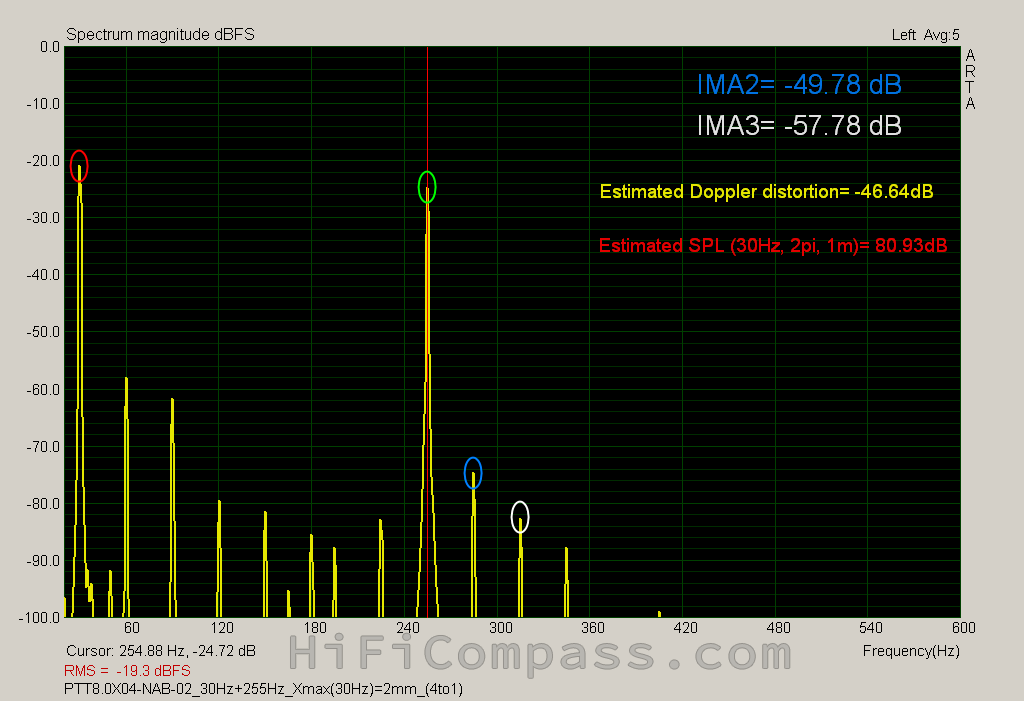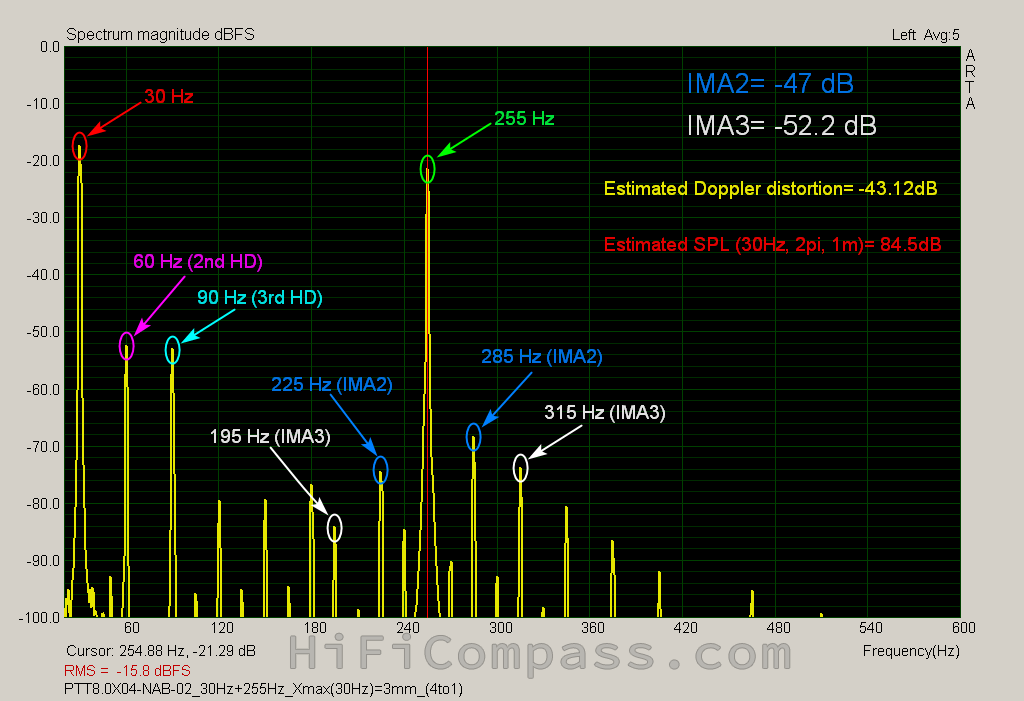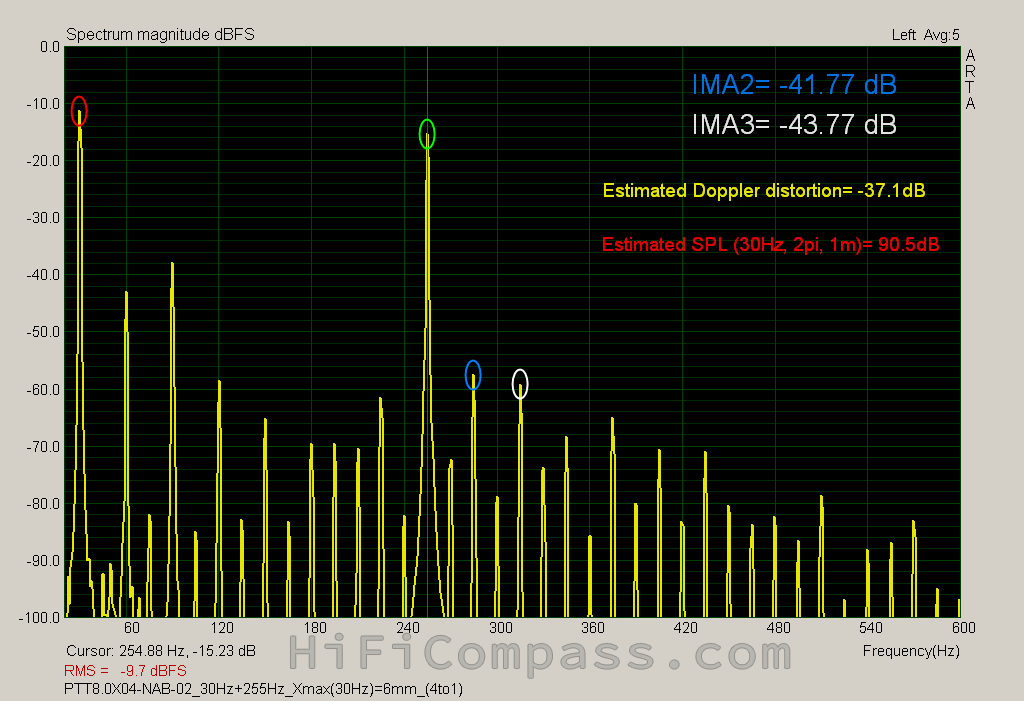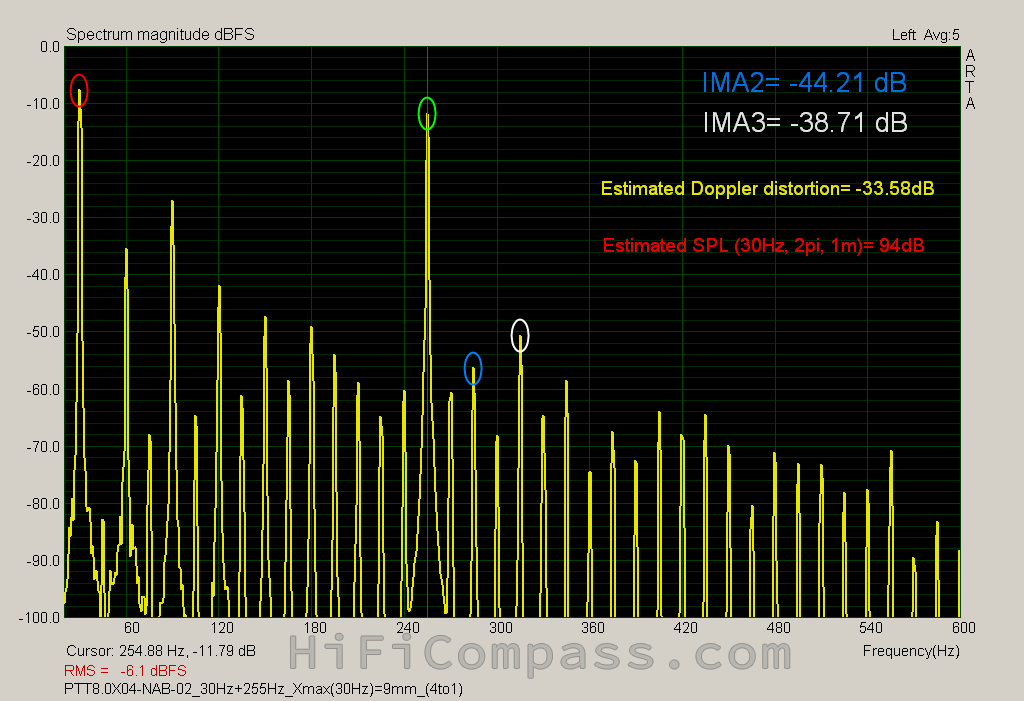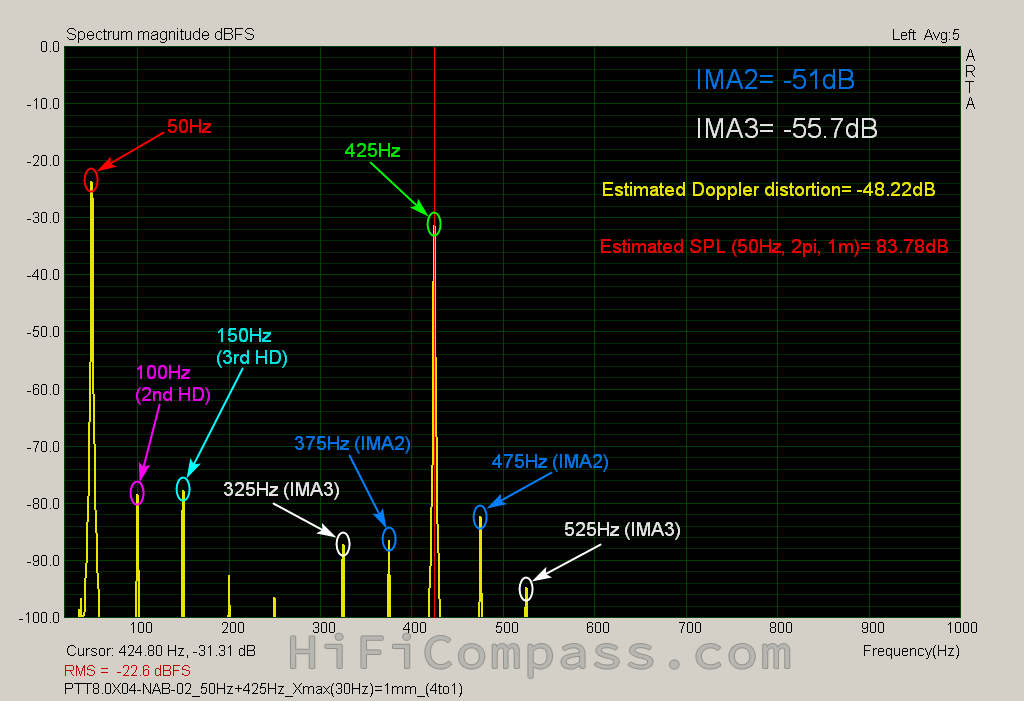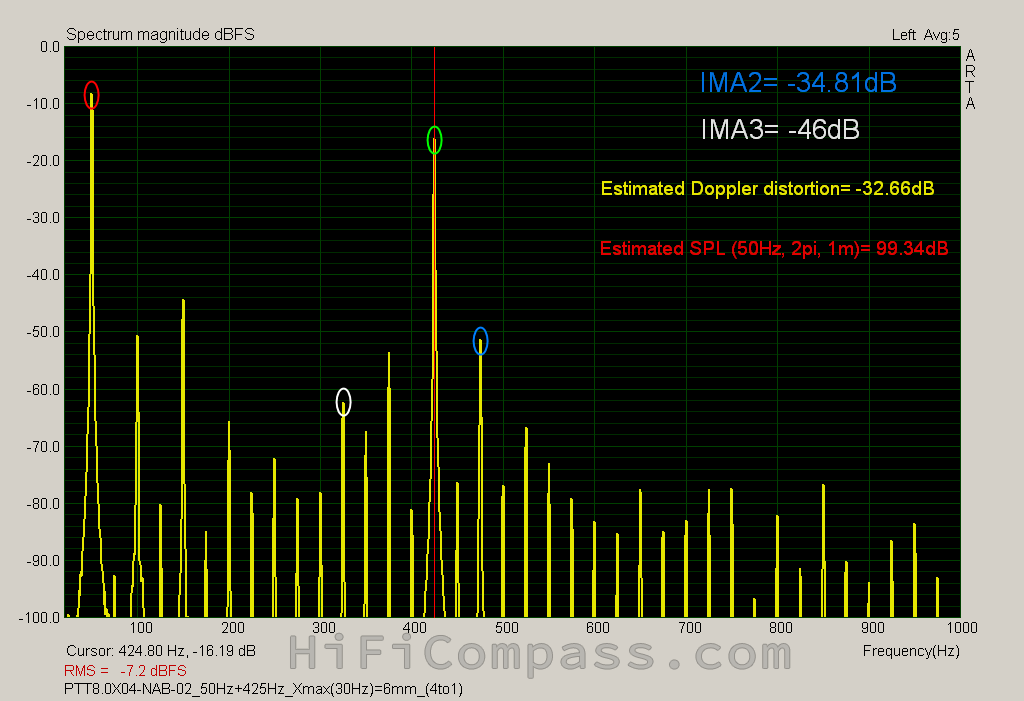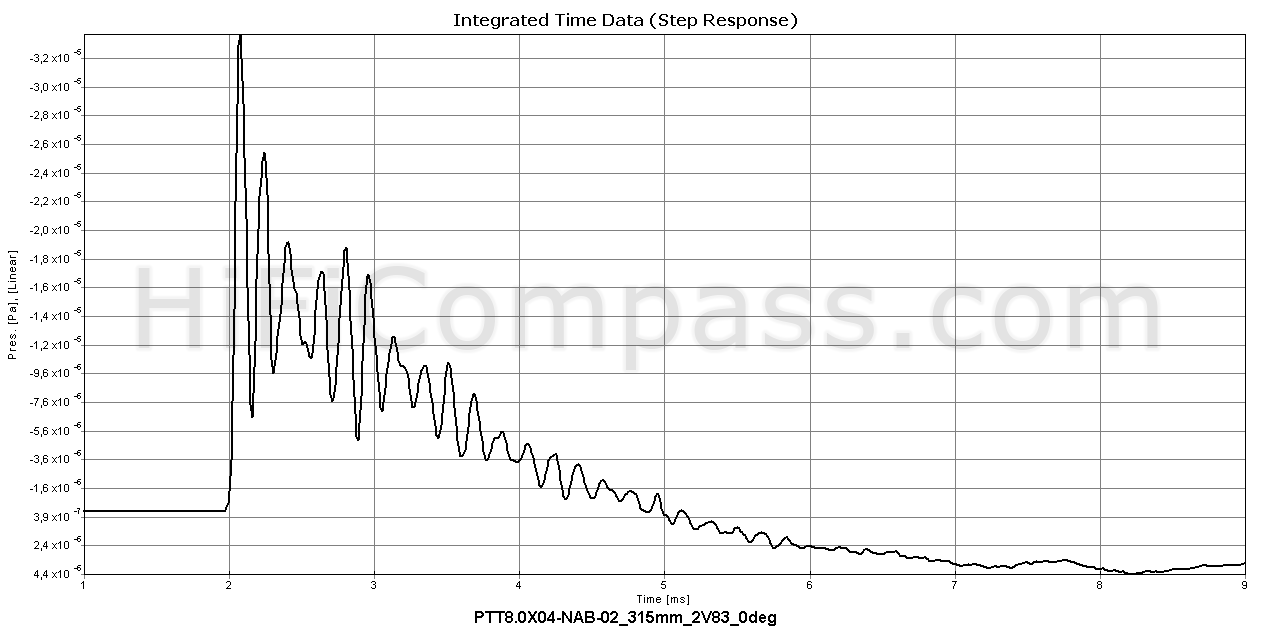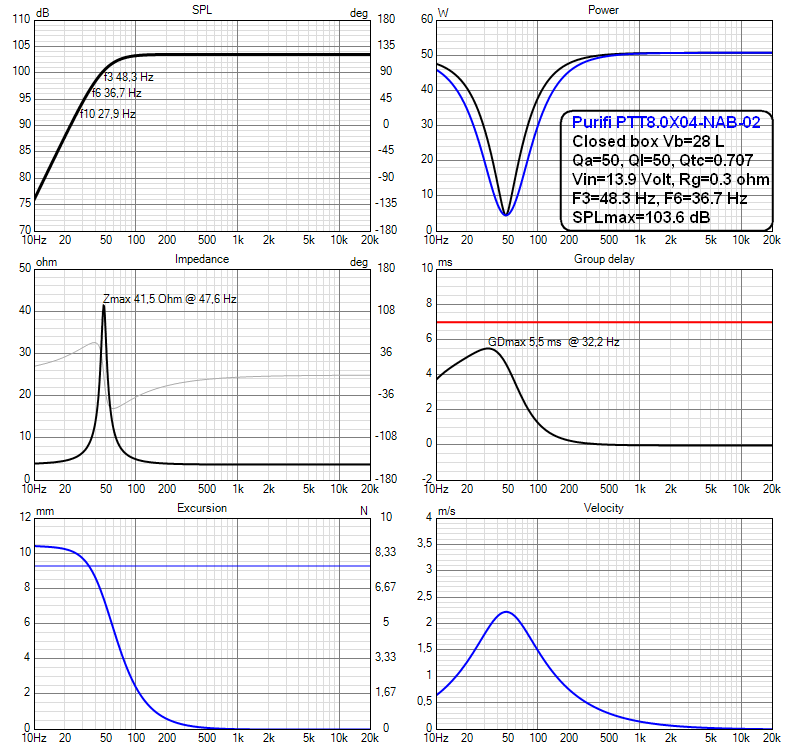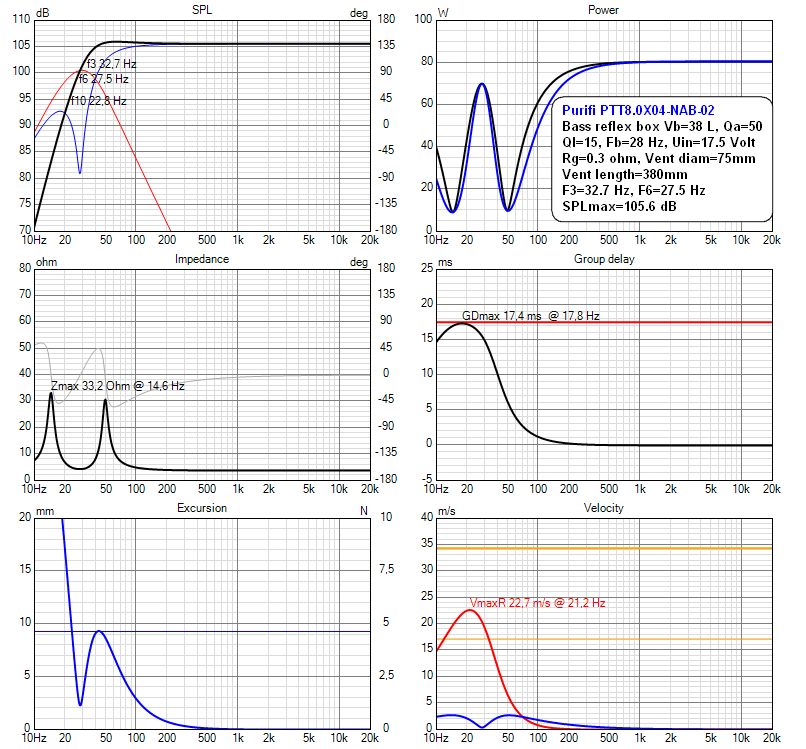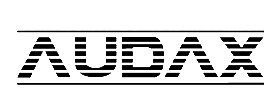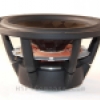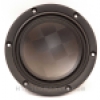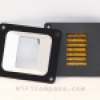HiFiCompass
Purifi PTT8.0X04-NAB-02 8" Alu midwoofer
What is on the test bench?
On March 30, 2022, the Danish company PURIFI announced a long-awaited novelty - a long-stroke 8" aluminum cone midwoofer PTT8.0X04-NAB-01. If we draw an analogy with boxing, then this next vertical expansion of their lineup corresponds to the moving from middleweight to light heavyweight. Yes, this "eight" with a membrane area of 235 cm2, a little more than we are used to seeing in this size of woofers (on average 220 cm2), and a linear stroke of +/-9.3 mm is already a serious fighter with a knockout punch.
The PTT8.0X04-NAB-01 was just a preliminary announcement, but a month later, the PTT8.0X04-NAB-02 model went into production, which today came under our scrutiny. The new midwoofer is available in 4-ohm and 8-ohm versions, PTT8.0X04-NAB-02 and PTT8.0X08-NAB-02 respectively.
As you will see shortly, the PTT8.0X04-NAB-02 is a scaled version of the 6.5" PTT6.5X04-NAA-08, but with a small difference - this is the first model in the PURIFI line to use a dual-layer voice coil instead of a four-layer voice coil.
And one more interesting point, the company started all its previous 4", 5" and 6.5" lines of speakers with models with paper membranes, but decided to start the 8" line right away with aluminum membrane. It is likely that this decision was the result of successful implementation, excellent feedback and the impressive performance of its predecessor PTT6.5X04-NAA-08.
You can read the history of the PURIFI company here.
Why do we test this?
Testing some of the best speakers in the world, especially new ones, as you might guess, is always extremely interesting and useful![]() .
.
I want to express my deep gratitude to PURIFI for kindly providing PTT8.0X04-NAB-02 midwoofers for testing, as well as personally to Lars Risbo, Claus Neesgaard and Morten Halvorsen for their time while discussing technical solutions used in the speakers and for the demonstrated logistic flexibility. The fact is that due to the military aggression of the russian federation against Ukraine, my country is under martial law, under which the vast majority of international logistics companies for obvious reasons refuse to provide their services. But as Lars Risbo well said: "Non-standard situations require non-standard solutions", and a solution was found. Even if not record-breakingly fast, but by the end of the year, after a month and a half of travel, the speakers had safely reached their addressee![]() .
.
What did the manufacturer state?
PURIFI has the most detailed and informative datasheets of any company I know of. In them you can find everything you need to design loudspeakers and even more.
In addition to very familiar plots of the axial SPL frequency response and the impedance frequency response, the following have been added:
- Force Factor and Stiffness vs Voice Coil Position
- Inductance vs Voice Coil Position
- Current Harmonic Distortion @ 1 kHz, 0-28.3 Vrms
- Sound Pressure Harmonic Distortion @ 1 m, 0-28.3 Vrms
- Intermodulation Distortion @ 30 Hz 80 dB, 255 Hz 80 dB
- Intermodulation Distortion @ 50 Hz 80 dB, 425 Hz 80 dB
Of the parameters of the midwoofer, the following should be noted:
- The double-layer voice coil - as I noted earlier, this is the first time it is double-layer, not four-layer. It seems to me that the priority for the designers in this case was to achieve the most balanced T/S parameters of the speaker in order to obtain good bass extension in passive designs. Without much effort it was possible to increase the strength of the motor, increase the output, but at the same time to get a low Qts and impossibility to achieve deep lows in passive designs
- Very low voice coil inductance - 0.18 mH, especially considering the length of the voice coil - 23.6 mm and its diameter of 52 mm!
- Acceptable sensitivity - 89.3 dB / 2.83 Volt * 1m
- Very high linear stroke of 9.3 mm (!) at one direction - it is a really long-stroke midwoofer
- The moving mass of Mms 43.2 grams - as for an 8" midwoofer, even with a cone area of 235 cm2, it looks more than usual values (22 - 35 grams). Although, the closest competitor Satori WO24P-4 with a moving mass of 42 grams (255 cm2) is not so far
Many people are skeptical if a midwoofer with such a high moving mass can reproduce a mid range with high quality. From personal three-year experience with the paper cone version of PTT6.5X04-NFA-01 in the two-way loudspeakers PuriBliss-BeWg and PuriWave, as well as with aluminum cone midwoofer PTT6.5X04-NAA-08, I can say that it for sure can and does it very good! Moreover, the experience of numerous owners, that has already been accumulated all over the world since the appearance of these midwoofers, also clearly indicates the complete failure of such a skepticism.
Visual inspection
As I noted, the external design of the speaker, is completely identical to the previous smaller 6.5" model, except for dimensions, so the description of their external attributes are almost identical.
- Packaging - durable packaging made of harde glossy cardboard with two-color printing. Inside the box, the speaker is fixed with cardboard inserts around the basket and magnet. There is an additional double corrugated cardboard insert at the bottom of the package for additional protection
- Workmanship - all at the highest level. No traces of glue, scratches, dirt or dust, spots and dents on the cone, chips on the ferrite magnet, gaps and skewness anywhere. There is nothing to complain about
- The basket - is aluminum alloy diecast with black microtextural powder coating. Acoustically very transparent. It is fixed to the magnet system by glue and four screws.
An interesting detail - the basket base, which is attached to the magnetic system, has a form not like a continuous ring, as in majority of other speakers, but has cuts between the ribs. The thing is that a solid basket base forms a short-circuited loop, which introduces asymmetry into the magnetic field at a large voice coil stroke, therefore to eliminate this effect the ring here was made split. Even this seemingly small detail was given attention during the development - The top and bottom plates of the magnetic system are made of metal, powder-coated black to improve heat dissipation and corrosion protection
- The magnet is made of ferrite, nothing special here
- The surround is very unusual. It is made of NBR rubber and in its shape resembles alternating mountain ridges. The four ridges look outward and other fours inward. The surround is absolutely symmetrical relative to the basket flange plane. This is the principle of PURIFI Neutral Surround - it is symmetrical, unlike conventional half-roll surround, so the effective radiation area remains constant throughout the entire voice coil excursion. In traditional half-roll surrounds the radiation area increases during the inward voice coile movement and decreases when moving outward, introducing additional nonlinearity.
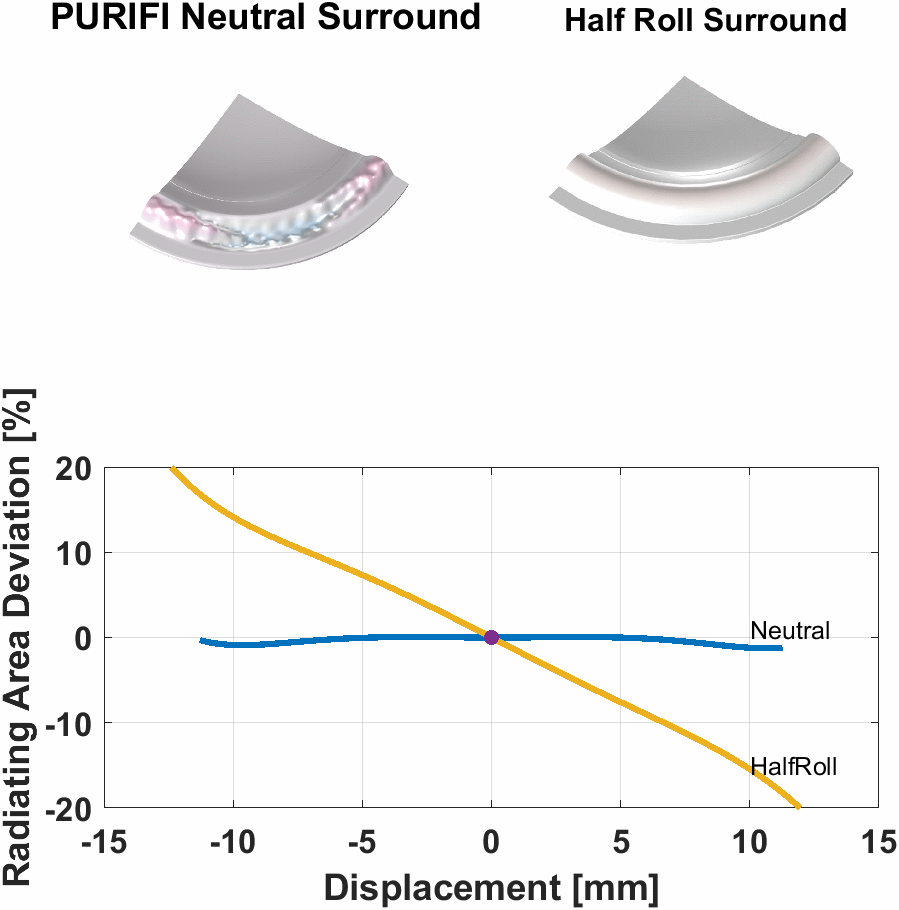
Lars Risbo recently posted an animation showing a visualization of a conventional half-roll surround and the original PURIFI Neutral Surround, as well as a comparison of the relative change in the effective area of a membrane with displacement. Let me attach it here for a better understanding of how it works.
For more information on this subject, I recommend reading the PURIFI patent -
The cone is made of aluminum and is protected from corrosion by deep anodizing in black with a pleasant silky semi-gloss sheen. The profile of the cone has a barely noticeable curvature. On the side of the neck, the cone has many holes for ventilation of the space under the dust cap.Also, as in the paper version, a paper stiffening rib of a triangular profile is glued along the edge of the back side of the cone. This helps increase the stiffness of the cone for combat the well-known "cone edge/surround" resonance and cone bending due nonuniform force from a neutral surround
- The dust cap is convex, with a variable curvature of the profile, resembling a bullet. It is made of the same material as the membrane
- The lead wires are silver plated
- The terminal block looks worthy and matches the status of the speaker. It is made of thermosetting plastic with gold-plated knife terminals molded into it
- The spider is made of BIMAX material. BIMAX is known for its durability and increased resistance to mechanical stress
- The voice coil former - is made of fiberglass. It is also a very popular non-conductive material, which allows to avoid additional losses from eddy currents, as in the case of aluminum formers, and to maintain high mechanical quality factor of the moving system. The former doesn't have ventilation holes
- The voice coil is very long, 23.6 mm, and protrudes noticeably out of the magnetic gap. The double-layer voice coil is wound with copper clad aluminum wire (CCAW) with variable pitch, which is one of the secrets of obtaining high linearity of BL(x) and Le(x) over the entire excursion range
Generally speaking, there are not the slightest complaints about the design of the speaker. The design and workmanship are at the highest level.
Impedance frequency response
The diagrams below show the frequency responses of the impedance of two midwoofer samples at different scales after they have been broken-in. The speakers were broken-in with a sinusoidal voltage of 9 Volts/26 Hz for 60 minutes:
The impedance curves and T/S parameters match each other perfectly, despite the fact that the midwoofers are shipped individually, not as matched pairs. Such a good consistency indicates a high technological level of production.
The measured values of the resonant frequency Fs=24.22 and total quality factor Qts=0.337 are slightly different from the stated values Fs=26 Hz and Qts=0.36. Most likely, this was due to a more intense broken-in of the speakers compared to the factory before taking the main parameters, which caused a slightly greater decrease in the Fs and Qts. Bearing in mind that during the broken-in process the "Fs/Qts" ratio remains almost constant, so that at the resonant frequency Fs=26 Hz these woofers will have a quality factor Qts=(26/24.22)*0.337=0.362, which is exactly according to the datasheet. So, there is no reason to doubt the T/S parameters from the datasheet.
The impedance curve is very smooth up to 4 kHz, after which the disturbances begin, reflecting the main resonance of the membrane and continuing up to 7.5 kHz. The peak of these disturbances is at 5.4 kHz, which corresponds to the first resonant peak of the axial frequency response.
In the region of 1 kHz at high magnification you can see a barely noticeable "flux" - this is what is left of the well-tamed edge resonance of the membrane and surround - nothing to talk about.
The increase in impedance with increasing frequency is extremely low for a 8" long-stroke midwoofer. This is due to the low inductance achieved by the double-layer voice coil and the large amount of copper in the motor. This low inductance, combined with its independence from cone displacement, contributes to a significant reduction in nonlinear distortion.
The frequency response of the impedance is a visiting card of the speaker and says a lot. In this case, it's about a low-loss well-balanced moving system and a great motor. Excellent!
On-axis frequency response
The diagrams below show the smoothed (1/12 octave) axial frequency response of one midwoofer and the unsmoothed frequency response of a pair of midwoofers:
The measured frequency response is fully consistent with the datasheet, and the frequency response of both samples are absolutely identical to each other. Excellent.
The measured sensitivity in the range from 300 Hz to 800 Hz averaged 89.15 dB, which, taking into account the measurement error, can also be considered an excellent match to the declared value of 89.3 dB.
In the range from 100 to 2300 Hz, the frequency response is quite even and smooth, the unevenness does not exceed +/-1 dB.
In the region from 700 to 1500 Hz, there are no serious signs of a typical "edge membrane/surround" resonance and only a smooth stepwise rise in the frequency response by 1.5 dB is observed.
Starting from 2.5 kHz, signs of approaching the main resonance of the membrane begin to appear and the frequency response gradually, a little unevenly, begins to climb to its first and highest resonant peak at 5.5 kHz, followed immediately by the second at 6.9 kHz. The height of the peaks reaches 17 and 14 dB, respectively. Then the frequency response begins to fall with a slope of about 12 dB / octave, bouncing a couple more times at frequencies of 10.4 and 14.6 kHz.
The developers managed not to drop the frequency range of the main breakup, even having increased the size of the membrane, however, the double-hump nature of the breakup of the 8" membrane is no longer as beautiful as in the 6" predecessor PTT6.5X04-NAA-08 (link to the frequency response). The main resonant peak has bifurcated and widened in frequency. The resonant amplification of the non-linear voice coil current products will be more intense, and therefore will need more careful suppression in a crossover when using the PTT8.0X04-NAB-02 in a two-way loudspeaker. In three-way loudspeakers you can simply forget about these problems.
In March 2022, PURIFI published an excellent application note "Low Distortion Filter for PTT6.5X04-NAA", which describes the mechanism of occurrence and method of dealing with the resonant amplification of current distortion. This document is simply a must-read for all loudspeakers designers, as this serious problem has almost never been paid due attention, even by manufacturers of high-end loudspeakers!
Off-axis frequency responses (315 mm)
The off-axis frequency response falls off evenly and monotonously with the deflection angle and frequency, as one would expect, however, at a frequency of 4.1 kHz, when viewed from angles of 15-60 degrees, an additional resonance unexpectedly appeared.
Harmonic distortion (315 mm)
Above are harmonic distortion curves for average sound pressure levels of 89 and 104 dB. To limit the speaker overload in terms of power and membrane displacement amplitude when measuring harmonic distortion, a second-order digital high-pass filter with cutoff frequencies of 50 Hz (at 2.83 Volts) and 80 Hz (at 16 Volts) was used. In these graphs, we analyze the frequency range only from 200 Hz and above.
Bursts of distortion in the range of 100-200 Hz are not related to the midwoofer, but to the resonances of the test baffle. When measuring in the near field (20 mm), the rigidity of the test baffle and the midwoofer fastening in my measurement setup is much higher.
Bursts of the 2nd, 3rd and 5th harmonics are marked in magenta, due to the resonant amplification of the voice coil current distortion products. In shape, they exactly repeat the double-humped shape of the frequency response in the region of the main breakup. The spike in 4th harmonic distortion is very hard to see but possible, especially when measured at 16 volts. The reason is the vanishingly small level of the 4th harmonic in the voice coil current, and therefore its share in the sound pressure is also extremely small.
The orange color marks the distortion spike caused by the hidden resonance at 4.1 kHz. It is far beyond the potential range of operating frequencies, so do not take it personally.
In general, the level of harmonic distortion in the range of 200-2000 Hz is extremely low and even lower than that of the 6" version of PTT6.5X04-NAA-08. Judge for yourself, the average level of total harmonic distortion in the range of 200-2000 Hz at a sound pressure level of 104 dB(!) is only 0.2% which is very cool. Right now, the PTT8.0X04-NAB-02 is the most linear 8" midwoofer I have ever held in my hands!
The harmonic distortion measurements are close to those published in the datasheet. Excellent!
Harmonic distortion (5mm - 20 mm)
Due to the specifics of my test setup, to analyze the nonlinear distortion of midwoofers in the frequency range up to 200 Hz it is more correct to use the results obtained by measurements in the near field at a distance of 5 to 20 mm from the cone. The diagrams below show harmonic distortion at voltages of 2.83 and 11.2 volts:
As the frequency decreases, starting from about 100 Hz, there is a sharp increase in harmonics of all orders. Distortion is due to a rapid increase in the cone excursion, which is inversely proportional to the square of the frequency.
The overall level of harmonic distortion below 100 Hz, as for a 8" midwoofer, can be rated as "very low".
The lower frequency limit, limited by distortion, for acoustic designs such as Bass Reflex or Passive Radiator can be considered 23-25 Hz, which is very cool. One of the features of these designs is the reduced cone excursion in the lower part of the operating frequency range compared to the design of the Closed Box type. This is achieved by delegating the functions of the main radiator from the speaker to the port tube or passive radiator in the region of their tuning frequency.
Voice coil current harmonic distortion
This type of measurement, despite its simplicity, is an excellent tool for assessing the linearity of a speaker motor. The above plots show the frequency dependences of the 2nd, 3rd, 4th and 5th harmonics of the voice coil current at 1.41 and 8 volt. To limit the speaker overload in terms of the membrane displacement when measuring harmonic distortion, a second-order Butterworth type high-pass filter with a cutoff frequency of 20 Hz was used.
Voice coil current nonlinearity is the direct nonlinearity of the mechanical force driving the speaker cone, since this force is related to the current by a simple relationship F=B*L*I, where B is the magnetic field strength, L is the length of the voice coil wire inside the magnetic gap and I is the current. So, in principle, it is practically impossible to obtain sound pressure distortion lower than current distortion in the frequency range where the contribution of the motional nonlinearity becomes insignificant.
Below 100 Hz, due to the increase in amplitude of the diaphragm displacement, harmonics of all orders begin to grow sharply. Above 200 Hz, even at 8 volts, the 2nd and 3rd harmonics are very low, the 5th harmonic is below minus 95 dB, and the 4th harmonic is even below the threshold of my measuring system. Just amazing results, I have not seen anything better yet. Bravo!
The intermodulation distortion measurement is one of way of to analyze the device non-linearity. It is not an alternative, but an additional method and allows you to identify the spectral components of the inharmonious structure, which are much more harmful for high-quality sound reproduction and to which our hearing is more sensitive.
There is a very good article of Bruno Putzeys - "Distortion, The Sound That Dare Not Speak Its Name", where he very well describes the mechanism and origins of the intermodulation distortions in a midwoofer, as well as introduces one interesting testing experiment that everyone can do. Its essence is the simultaneous supply of a musical signal to a midwoofer such as singing (rather than a speech, for better audibility of the effect) male or female vocals, or a violin, clarinet, flute, and sine wave signal with frequency of 30 Hz, the level of which can be adjusted. The sine signal causes a large cone excursion, which leads to the appearance of non-linearity of the suspension and the force factor. The suspension nonlinearity leads only to the appearance of harmonic distortions of the 30 Hz sine signal and does not affect the reproduction of midrange, while the modulation of the force factor leads to a change in the sensitivity of the speaker for midrange frequencies. This changing is manifested in the amplitude modulation of the voice notes with 30 Hz sine. Try this experiment yourself and you will be very surprised how audible intermodulation distortions are and how they grow with an increase of the low-frequency component. Perhaps this will be a great discovery for you.
I also highly recommend to study the topic on the topic from the PURIFI blog - Low frequency harmonic distortion is almost inaudible. So what’s the point of low distortion drivers?
For testing I chose the frequencies of 30 Hz and 255 Hz. With this ratio (1:8.5) the contribution of the Doppler distortion is not yet dominant and the contribution of amplitude modulation can still be observed. In addition, this is a very realistic situation that occurs in both two-way and three-way systems. The measurements were performed for different 30 Hz cone excursions and their conditions are indicated in the lower left corner of each plot. By various colors are indicated:
- test frequencies
- 2nd order harmonic distortion components for the test frequencies (2nd HD)
- 3rd order harmonic distortion components for the test frequencies (3rd HD)
- 2nd order intermodulation distortion components (IMA2)
- 3rd order intermodulation distortion components (IMA3)
The graphs above show the IMD spectrum for 2mm, 3mm, 6mm and 9mm membrane excursion with a 30 Hz modulating signal.
However, in these plots products of the motor nonlinearity are mixed with products of inevitable frequency modulation of the Doppler effect. How do you define who is who? We can analytically estimate the level of the first pair of the side Doppler components using the following formula [http://www.linkwitzlab.com/frontiers.htm#J]:
As(dB) = 20*log10(pi*A1*f2/c), where pi=3.14, A1- the modulating signal amplitude in meters, c=343 m/s, f2 - carrier frequency. In our case f1 = 30 Hz, f2 = 255 Hz.
Aplying the last formula we get the maximum level of spectral components corresponding to Doppler distortion is approximately as follows:
d.f. (3 mm) = -43.12 dB
d.f. (6 mm) = -37.1 dB
d.f. (9 mm) = -33.58 dB
It can be seen from the graphs that the levels of the measured spectral components for PTT8.0X04-NAB-02 at different amplitudes of the modulating signal are:
For 3 mm = -47 dB (IMA2)
For 6 mm = -41.77 dB (IMA2)
For 9 mm = -38.71 dB (IMA3)
Surprisingly, the levels of the measured lateral components of the intermodulation distortion turned out to be noticeably below the threshold values determined by the Doppler distortion. This means that fundamentally irremovable frequency modulation completely dominates the amplitude modulation determined by the non-linearity of the speaker motor. Great result!
I also decided to check the reliability of the manufacturer's data for a pair of frequencies 50 and 425 Hz. The manufacturer doesn't specify the amplitude of the membrane displacement, but the sound pressure of 80 dB at a distance of 1 m when radiating into a half-plane. I made measurements for membrane amplitudes of 1 mm and 6 mm, which, according to calculations, should create a sound pressure of 83.78 dB and 99.34 dB:
It is easy to see that even at a slightly higher SPL of 83.78 dB the distortion spectrum is almost identical to the datasheet in terms of shape and the levels of the spectral components.
You may ask, what difference does it make, what mechanism is the source, because the parasitic spectrum still appears? The fact is that there is an assumption that our hearing is much less susceptible to a frequency modulation compared with an amplitude one. There is an interesting article published in the Stereophile on Doppler distortion and its audibility - Red Shift: Doppler distortion in loudspeakers, and also a must-read topic from the PURIFI blog - Doppler distortion vs IMD?
To date, the PTT8.0X04-NAB-02 has the lowest IMD of any speaker I have tested.
Step response
Good transient response - fast front, monotonous decay, no overshoot, but noticeably spoiled by the parasitic oscillatory process sitting on it, caused by membrane resonances. After filtering in the crossover, there will be no trace of it, so you should not take it too seriously.
Waterfall
The waterfall shows the same effects as a step response, in addition exposing hidden resonances that are difficult to see in other types of measurements. In this case, no new problematic resonances were found.
We see a very fast decay during the first 0.5 ms and monotonous, uniform decay throughout the entire frequency range up to 2.5 kHz. It's good.
The main resonance of the membrane at 5.5 kHz is characterized by a high quality factor and leaves behind a long tail that extends well beyond the first three milliseconds. You can’t leave it unattended in any way, but you will have to neutralize it either with a high-order low-pass filter or with a narrow-band notch.
As usual, after completing the measurements, I started listening to the midwoofer in the test baffle on a wide variety of musical material. No filtering was applied to the speaker, except that the frequency response was equilized in the break-up region by a digital signal processor.
In the previous review, I described in sufficient detail my impressions of the sound of the 6" predecessor with an aluminum cone PTT6.5X04-NAA-08. The sound character of the new PTT8.0X04-NAB-02 is almost the same. It's clean, clear and precise, thanks to the extremely low intermodulation distortion.
Surprisingly, at any volume level, there is absolutely no audible distortion. The extremely low aerodynamic noise is impressive even at extreme cone amplitudes.
The bass is perfectly articulated and fully retains its structure at any volume level. I would describe it as precise, without false embellishment. This is a real bass, not greasy, not bloated, not sluggish, but on the contrary - weighty, dense and solid, i.е. with a excellent attack and well-defined temporal contours.
The middle and upper midrange are crystal clear, transparent and dynamic. The feeling of light, natural and lively sound.
Complex classical orchestral music sounded very clear and with good separation of musical instruments. It was the same with rock music, from hard rock to thrash metal, without a hint of "porridge".
Most of all I liked how the midwoofer handles electronic and dance music (EDM) - very driving, energetic, lively, transparent, with excellent rhythm transfer.
I would characterize the overall timbre of the sound from a more dry-analytical side than from colorful and lush one like speakers with paper cones - there is nothing new or surprising here, this is a feature of absolutely every speaker with aluminum membrane that I have heard.
"How to use" recommendations
Due to extremely low non-linear distortions, even frequency response and good midrange reproduction, the long-stroke PTT8.0X04-NAB-02, despite its size, can really be called a midwoofer, and not just a woofer. A fairly versatile speaker and can be used in both three-way and two-way loudspeakers.
It is difficult to name the upper limiting frequency of application, it all depends on the concept of the loudspeakers and the designer's opinion on the permissible narrowing of the radiation pattern in the upper midrange. Formally, from the point of view of non-linear and linear distortion, nothing forbids using it up to 3 kHz.
Due to the optimal combination of T/S parameters, the long-stroke PTT8.0X04-NAB-02 can easily be used in a bass-reflex configuration in a box of reasonable internal volume and reasonable port dimensions, which allows squeezing out the full potential of the midwoofer's air volume excursion.
There are no problems with the Passive radiator design, but I don't see any advantages over the Bass-reflex one, except for a significant increase in the cost of the design.
The Closed box type is also no problem, and thanks to the long-stroke design it is possible to actively compensate early roll-off at low frequencies.
Below are simulations of the midwoofer operation in a Closed box and Bass-reflex design:
As you can see, both designs give excellent results. The Bass-reflex at the cost of a slightly larger group delay at the lowest frequencies and larger dimensions (+10 liters of the internal volume of the enclosure) allows you to achieve a much lower cutoff frequency (32.7 Hz vs. 48.3 Hz), a higher maximum SPL (105.6 vs. 103.6 dB) and lower distortion below 40Hz. Everyone must decide for himself which design is more optimal for his taste and application conditions.
Formally, taking into account the maximum linear volumetric air displacement, a pair of PTT6.5X04-NAA-08 midwoofers is capable of providing a 1.5 dB higher maximum SPL at the same low cutoff frequency, compared to one PTT8.0X04-NAB-02. However, this can be achieved, firstly, only with active low-frequency correction, and secondly, the cost of a pair of 6" midwoofers is 35% more compared with one 8". If we talk purely about the passive design, without an active correction, then a pair of 6" is simply not allows you to get such a deep low end as one 8" in any enclosure design.
What is the price and where to purchase it?
You can buy PTT8.0X04-NAB-02 midwoofers both directly from PURIFI and in various online stores. The retail price is in the range of €570/unit excluding VAT.
- https://purifi-audio.com/vare/ptt8-0x0z-nab-02/
- https://www.soundimports.eu/en/purifi-ptt80x04-nab-02.html
- https://www.madisoundspeakerstore.com/8-woofers-4-ohm/purifi-ptt8.0x04-n...
Summary
The testing confirmed the full compliance of all measured parameters and characteristics with the datasheet. The consistency of parameters from sample to sample is excellent.
The midwoofer PTT8.0X04-NAB-02 has become my new reference for the level of harmonic and intermodulation distortion in the 8" segment.
It is the best aluminum cone 8" midwoofer I've ever heard.
So, what can be noted:
- Quite a healthy sensitivity - 89.3 dB/2.83 volt*1m
- Very long linear stroke - 9.3 mm per one way
- Really working PURIFI Neutral Surround technology
- Rigid aluminium membrane
- Very low harmonic distortion
- Very low intermodulation distortion
- Excellent production quality
- Even and smooth frequency response
- Upper frequency limit up to 3 kHz
-
Applicable in any type of loudspeaker enclosure design without any practical limitation
You can get more information about the measurement results here
P.S. One more review of the PTT8.0X04-NAB-02 from Erin - https://www.erinsaudiocorner.com/driveunits/purifi_ptt80x04-nab-02/
Yevgeniy Kozhushko/15.01.2023
CONTACTS
- Ukraine
- (+380) 95 904 7827
- hificompass@gmail.com
LAST NEWS
-
04 Mar 2025
-
25 Feb 2025
-
10 Feb 2025
-
01 Feb 2025
